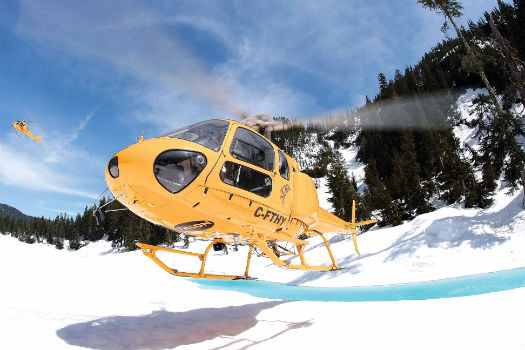
With a fleet of just five helicopters, Talon Helicopters has developed a diverse client list of about 300 different customers. Mike Reyno Photo
One of the reasons Vancouver has become the hotspot it is for movie and TV production is the variety of locations offered within a relatively small area. It has a bustling downtown, a picturesque harbor, extensive parks, beautiful beaches, snow peaked mountains and ancient forests. And with the enormous variety of pursuits its geography enables, there are a similarly diverse range of opportunities on offer for enterprising helicopter operators.
The urban environment offers challenging aerial videography work, VIP transport and aerial sightseeing; while the rural surroundings offer powerline construction, aerial surveys, and firefighting work. The mountains and lakes also attract large numbers of outdoor enthusiasts — leading to a regular need for search-and-rescue (SAR) missions.
There’s one operator in particular that has taken full advantage of the various opportunities presented in and around the city, diversifying like few others while maintaining a level of service that has seen it grow a client list of about 300 different customers — with a fleet of just five aircraft. That operator is Talon Helicopters.
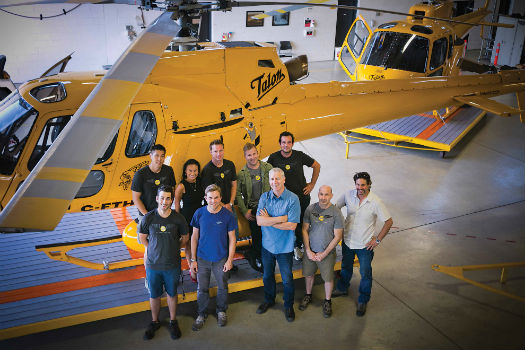
There are 10 people in Talon’s crew, including company president and owner Peter Murray. “I don’t like calling them the staff — they’re the crew — because we all work together,” he said. “I understand that people that are working are offering me and Talon just as much as I’m offering them.” Heath Moffatt Photo
Company president Peter Murray, a born and bred Vancouverite, established Talon in 1997 after previously working as a base manager for another operator in the city.
“It’s not a big city by any stretch, but it’s a great city,” he told Vertical. “Going out flying the [CTV] news machine, search-and-rescue, firefighting, bucketing, moving crew around — I enjoy it all. And that’s one of the things about Vancouver, it’s such a beautiful place to fly around.”
And, while he loves working in the city, he freely admits that it may not be the type of lifestyle that would suit many in the industry.
“It’s a very niche market here,” he said. “It’s not like the majority of helicopter flying in Canada. It’s probably the minority in that we do a lot of interesting and varied work in Vancouver.”

Talon operates two Airbus Helicopters AS350 AStars — one BA and one B2. In January, Vector Aerospace (a subsidiary of Airbus Helicopters) will be converting the BA to a B2 — the first time Vector will have completed such a conversion. Previously, operators in Western Canada needed to ferry their aircraft across the country to the Airbus Helicopters Canada facility in Fort Erie, Ont., for this conversion. Mike Reyno Photo
An Intermediate Focus
Murray describes Vancouver as “an intermediate world,” and this is reflected in Talon’s fleet. It owns a Bell 206L-4 LongRanger, an Airbus Helicopters AS350 B2, an AS350 BA, and an AS355 F2 MAX — a customized version of the AS355 F2 TwinStar. The company also leases an Airbus Helicopters EC120 B.
“We’re not a big company,” said Murray. “We get aircraft as we see the requirement for work. We don’t buy a bunch of machines and hope that it shows up.”
The evolution of the AS355 F2 into the F2 MAX speaks volumes about Murray’s general philosophy — an exacting attention to detail to deliver the best possible product. Dissatisfied with the F2’s existing wiring systems, he began an 18-month process to design, create and certificate a new system, working together with Pitt Meadows, B.C.-based Maxcraft Avionics.
“I’m not an engineer, but I try to understand as much as I can about the mechanics of the machine — especially electronics,” said Murray. “The TwinStar is a beautiful helicopter, but the wiring system was a two out of 10. We used LED Vivisun switches, which are expensive but reliable, and we got rid of most of the connectors, because they didn’t handle the vibration, dust, heat, and cold well. And we made a simpler system.”
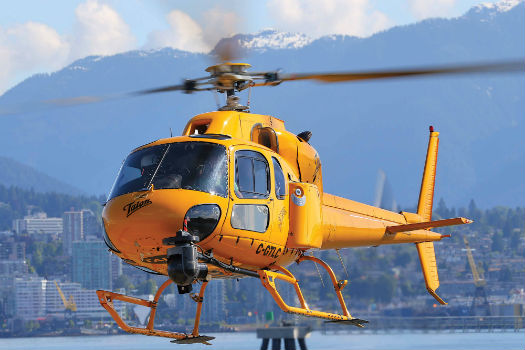
Talon owns mounts for a variety of camera systems, and all its aircraft have been modified to accommodate them. Jeff Wilson Photo

Talon’s AS355 F2 MAX over downtown Vancouver. Graham Lavery Photo

Talon has operated “Chopper 9” — a Bell 206L-4 LongRanger — for Vancouver’s CTV news since 2004. Heath Moffatt Photo
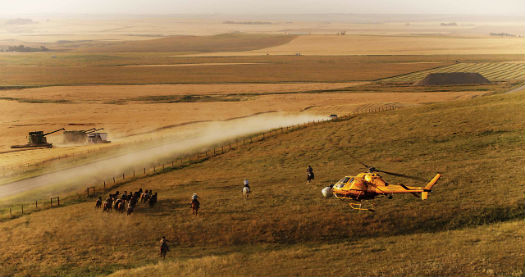
Talon’s TwinStar during filming for Sherpas Cinema’s FlyOver Canada project. Sherpas Cinema Photo
The TwinStar is generally used for SAR missions and any kind of low flying work the company performs — from filming to aerial mapping. Talon doesn’t have a contract for SAR work, but because of its longstanding relationships with Vancouver’s various rescue associations (in particular, North Shore, Coquitlam, Lions Bay, and Chilliwack) — and Murray’s insistence on 24/7 availability and response — the company flies out to assist on about 100 calls each year.
Talon always has an aircraft ready to respond to SAR work, and also spends a great deal of time training with the city’s rescue teams on weekends. Murray himself is an expert in long line rescues, with over 20 years’ experience performing Class D missions. In 2010, he was recognized with the Leadership Award of the National Search and Rescue Awards of Excellence Program for exemplary service, commitment and dedication to search-and-rescue services.
Murray said the company takes time before deciding whether to certify new pilots to perform Class D rescues. “We like to see what their personalities are, how they work with the crew, how they perform in non-Class D environments — a lot of stuff beyond what’s required by law.”
And while the TwinStar is usually the aircraft of choice for SAR work, Murray said he’s comfortable using other aircraft, too. “I have no problem with doing a Class D rescue with either an AStar or a Twin — because the risk of an engine failure right at that particular moment is very very small. However, because we have a Twin and it’s right here, ready to go, and it’s very capable — I prefer that we go do it in a Twin.”
All Talon’s pilots have night ratings, but the company does not use night vision goggles — yet. “It’ll happen one day I’m sure,” said Murray. “But I question the safety and the requirements — and what about crewing? How are you possibly going to meet the regulations with crew duty times that say you can come at night?”

Talon’s fleet of five aircraft includes the highly customized AS355 F2 MAX (center) and two AS350 AStars. Heath Moffatt Photo

Talon completes about 100 search-and-rescue missions each year, and trains regularly with rescue organizations around Vancouver. Mike Reyno Photo
A Bird’s-Eye View
Talon has been operating “Chopper 9” for Vancouver’s CTV News since 2004. The Bell 206L-4 LongRanger, equipped a FLIR camera system and digital microwave downlink, is the only helicopter dedicated to news coverage in the city, and served as “Canada’s Olympic Chopper” during coverage of the 2010 Vancouver Winter Olympics.
The aircraft is on call seven days a week, and CTV has been given a dedicated office to house its camera operators and reporters at Talon’s base at Vancouver International Airport.
“They’re excellent to work with,” said Murray. “They leave the flying to us, and we just try to work with them to get news stories safely without breaking any regulations or causing any grief for anybody.”
A related area of operation, but one in which the company has seen a huge amount of growth in recent years, is in aerial filming. Today, Talon’s extensive customer list includes Columbia Pictures, Warner Brothers, Disney, Fox, and the BBC; with recent credits including Elysium, Sherlock Holmes, Fringe, and the upcoming Seth Rogen and James Franco movie, The Interview.
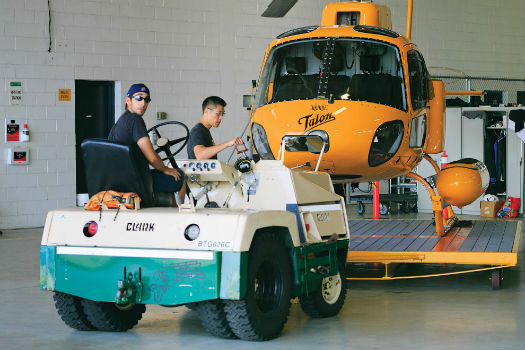
The Talon fleet is looked after by a crew of three aircraft maintenance engineers (AMEs). Heath Moffatt Photo
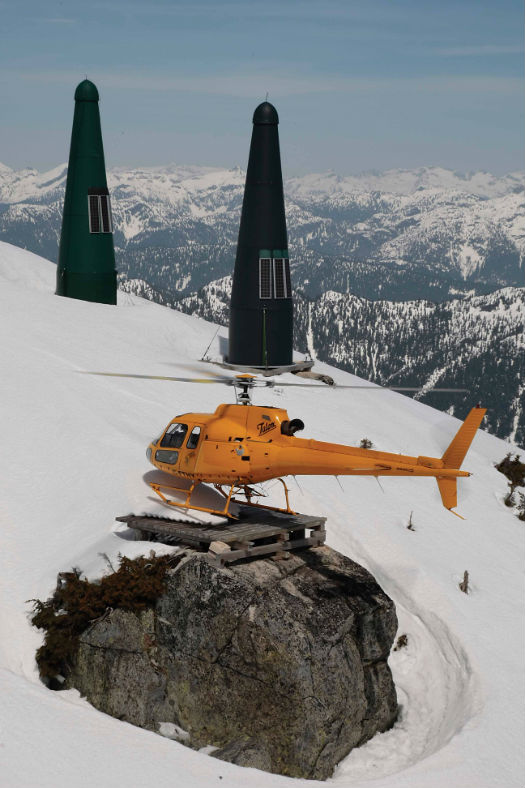
The distinctive color of Talon’s aircraft makes them instantly recognizable — and highly visible to other aircraft in the often reduced visibility conditions of the West Coast. Mike Reyno Photo.
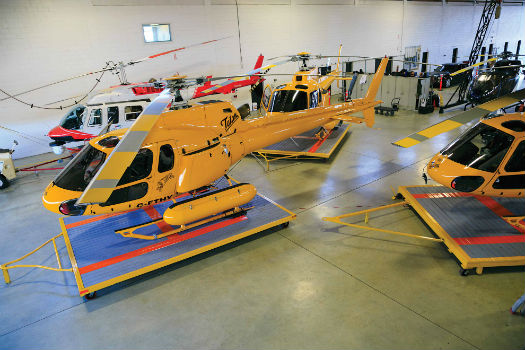
Talon’s hangar at Vancouver International Airport. Heath Moffatt Photo
To better serve the film production market, Talon has purchased mounts for the various camera systems in use — including those from Cineflex, Wescam and Eclipse — and modified all its aircraft to accommodate those mounts.
“We have tons of roll equipment, and we’ll do 40 to 50 installs a year per aircraft,” Lorne Lambert, Talon’s director of maintenance, told Vertical. He said each one takes between two and eight hours to install and balance — and sometimes two different camera setups are required on a single aircraft in one day.
“For me, film work is the same level as search-and-rescue and firefighting,” said Kelsey Wheeler, Talon’s chief pilot. “A lot of it is low level, and there can be a lot going on. You’ve got to have a bit of a plan going in — it’s not something you can rush into. There’s typically a lot more going on because you’re getting feedback as you’re flying as to how somebody else wants you to put the machine.”
It was only after Wheeler joined Talon eight years ago that he got his first experience of aerial filming, and he’s gradually built from working on documentaries to more dynamic movie requests — such as chasing people, cars or planes.
“I’ve really only worked with great people — you hear all those stories of crazy directors and that sort of stuff, but everybody has been fantastic on set,” he said. “There’s always the little added pressure because, especially with feature films, you may only have one or two chances to get the shot and there’s a lot of money riding on it. But everybody I’ve worked with always understands that everybody is trying to do the best job they can and do it safely.”
Another traditionally strong area of operation for Talon is in aerial firefighting — which has taken the company as far east as Quebec — but Murray said the company hasn’t had a busy fire season since 2011, when it leased a number of aircraft to contribute 10 percent of the intermediate firefighting fleet working in Ontario.
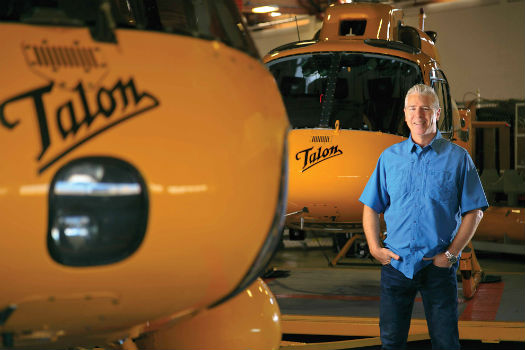
Talon president Peter Murray established the company in 1997. Heath Moffatt Photo
A Commitment to Safety
The distinctive bright yellow of Talon’s aircraft makes them instantly recognizable to those familiar with aviation in Western Canada. And while this is a happy side-effect of choosing such a strong color, the primary reason Murray did so was for safety. “We’re in a VFR [visual flight rules] world. What’s the most important thing? It’s to be seen,” he said.
“When it’s overcast, you look at the sky and it’s grey. When you fly on those kind of days, you want everybody to see you. I’ve been out on fires where the pilots who were bucketing out of the same pond have said to me, ‘I love that color — because I see it before I even see your landing light or your strobes.’ Even though we add all the extra strobes we possibly can on the machine, the color is still the overriding aspect that gets identified.”
Murray is rightly proud of Talon’s spotless safety record, and said it was important for safety to be embedded within the culture of an organization rather than just a convenient motto.
“We’re not afraid to tell the customers they need a bigger helicopter,” he said. “Not only are we not afraid, it’s the right thing to do. . . . There’s still an old-school group [of pilots] that’ll say, ‘The aircraft will lift it, so let’s just do it.’ We calculate our weights, and if it’s over gross, we don’t do it. That’s just it. That’s how I fly, and that’s how I talk to the crew about it. There’s no way they’re going to do it.”
Including Murray, Talon has 10 employees, including five full time pilots and three aircraft maintenance engineers. For Murray, the people at Talon are the key to its success. “We have a very high standard and a high expectation of a good work ethic, and we look for people who are polite, calm, and skilled.” Murray admitted that it isn’t easy to find the right people (who are prepared to move to expensive Vancouver), but his crew is clearly highly valued. “I understand that people that are working are offering me and Talon just as much as I’m offering them. We have a fantastic team, we really do, and everybody there is a key player in that team.”
And Murray isn’t just talking about the pilots and maintenance team; he’s keen to highlight the work of operations assistant Jeanette Lim. “The story of Talon is not complete without mentioning Jeanette,” he said. “She is frontline with our customers, conveying a positive image at all times, and is absolutely a key ingredient in our success.”
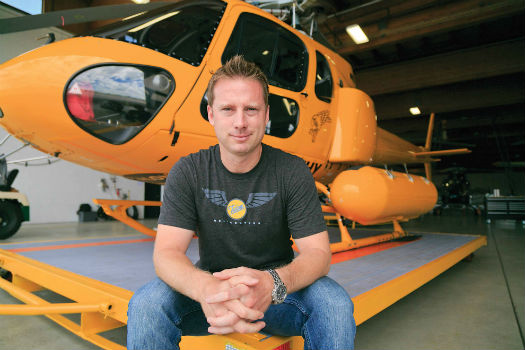
Kelsey Wheeler has been chief pilot at Talon Helicopters since 2008. Heath Moffatt Photo
Chief pilot Kelsey Wheeler said the minimum qualifications Talon looks for from new pilot hires is 2,000 hours with mountain and long line experience — along with the right attitude.
“We want them to be happy doing even a 20-minute tour with four people who won a gift certificate that have never been in a helicopter — because obviously that’s going to be the highlight of their week, their month, or their year,” he said. “We need people who love aviation and everything that goes along with it — the good, the bad and the unpredictable parts of it. We get resumes from guys that have 10 or 12,000 hours, and then you talk to them on the phone and you can tell it’s unfortunately just become a job.”
Maintaining Availability
According to Murray, another one of the keys to the company’s success is in simply being available — whenever a potential customer needs them. “Time and time again I hear from new customers: ‘You’re the only company that answers the phone!’ We’re ready to go with equipment that’s right for the job, our helicopters are right for the job, and our crews that are right for the job as well. That’s our biggest strength.”
According to director of maintenance Lorne Lambert, forward planning is crucial to ensuring an aircraft is always available.
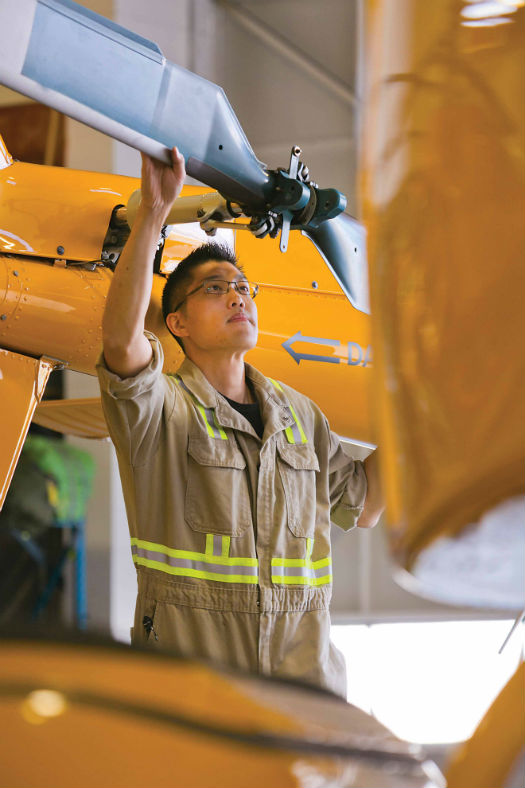
AME Norman Wong inspects a tail rotor at Talon’s Vancouver hangar. Heath Moffatt Photo
“A lot of companies plan specific maintenance, [but] we have to kind of think on our feet, and be ready to do an inspection 50 or 60 hours early. Because all of a sudden the machine could be gone [on a contract] for three weeks.”
As for Chopper 9, maintenance needs to be planned around CTV’s 11 a.m. to 7 p.m. schedule. “Touching it [during the shift] is forbidden unless we absolutely have to,” he said. “But there is definitely consideration for maintenance in the contract, we just try to give them as much notice as possible. If they say, ‘No, there’s the Olympic torch coming through the province for the next three weeks,’ — we just have to schedule component replacements earlier.”
One thing that strikes most visitors to Talon’s hangar (certainly those that have been around a lot of utility aircraft) is how spotless the aircraft are — inside and out. “The machines are gorgeous,” said Lambert. “A lot of companies kind of neglect the cosmetics, but Peter is pretty strict on ensuring that everything looks good; everything is top notch.”
According to Murray, he’s worked on fires with a 12-year-old aircraft that fire crews have thought was brand new. “When people are paying as much as they do for helicopters — $2,000-plus an hour for intermediates — it should look like that to me. They don’t have to be new, because new is not better. What they need to be is maintained in a better than new condition.”
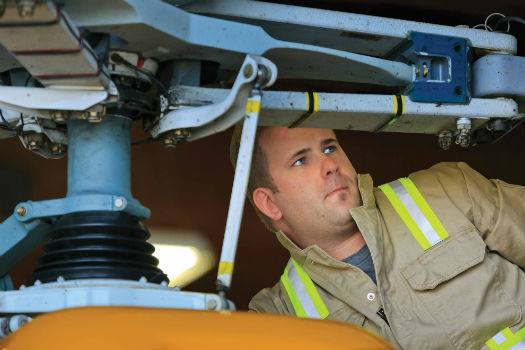
Director of maintenance Lorne Lambert said that maintaining 24/7 availability is key to the company’s success. Heath Moffatt Photo
The same philosophy that drove the development of the F2 MAX also drove the development of standardized instrument panels in Talon’s aircraft and new on-board hooks.
“Every machine that we use for long lining has the collective release, the manual release for the belly hook, and they’re all in the same spot,” said Murray. “I’m big into standardization. A lot of companies talk about it, but then they don’t do it. We do it. I’ve paid extra money to put the same cyclic, the newest French cyclic, in each machine. We’re trying to reduce risk, and get the latest products out there that we can on the aircraft.”
The capital-intensive nature of the helicopter industry is a major challenge in itself, according to Murray, and it’s Talon’s “managed” growth that has allowed it to flourish — especially in the highly competitive West Coast. “We’ve had those wealthy competitors come and go, but we’ll continue what we’re doing — upgrading our fleet slowly at the right time,” he said. “It’s a recipe that works.”
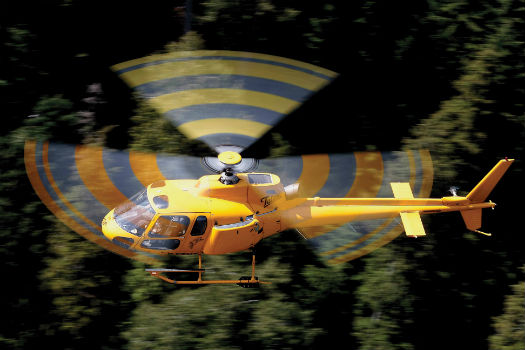
Talon’s aircraft are kept in immaculate condition — inside and out. Mike Reyno Photo
When asked what his favorite type of mission is, Murray finds it hard to choose. “I actually love it all to be honest with you — you’ve got the ocean, islands, and such incredible geography and scenery to fly around in Vancouver. When we’re doing film work, a lot of the time it’s during the best light, so I enjoy that. But there’s no question that when you get out there and things go right, and you help somebody out on a rescue… It’s a hard to describe feeling, but you feel like you did good today.”
With such clear passion for his work, a love for area in which he does it, and a commitment to excellence, it’s not surprising that Murray’s company has become Vancouver’s VFR go-to.
Oliver Johnson is managing editor of Vertical Magazine. He can be reached at oliver@mhmpub.com.





